
Reimagining the Superyacht
While concept yachts may seem out of this world, many of their design elements are rooted in reality and offer a glimpse into the future of yachting.
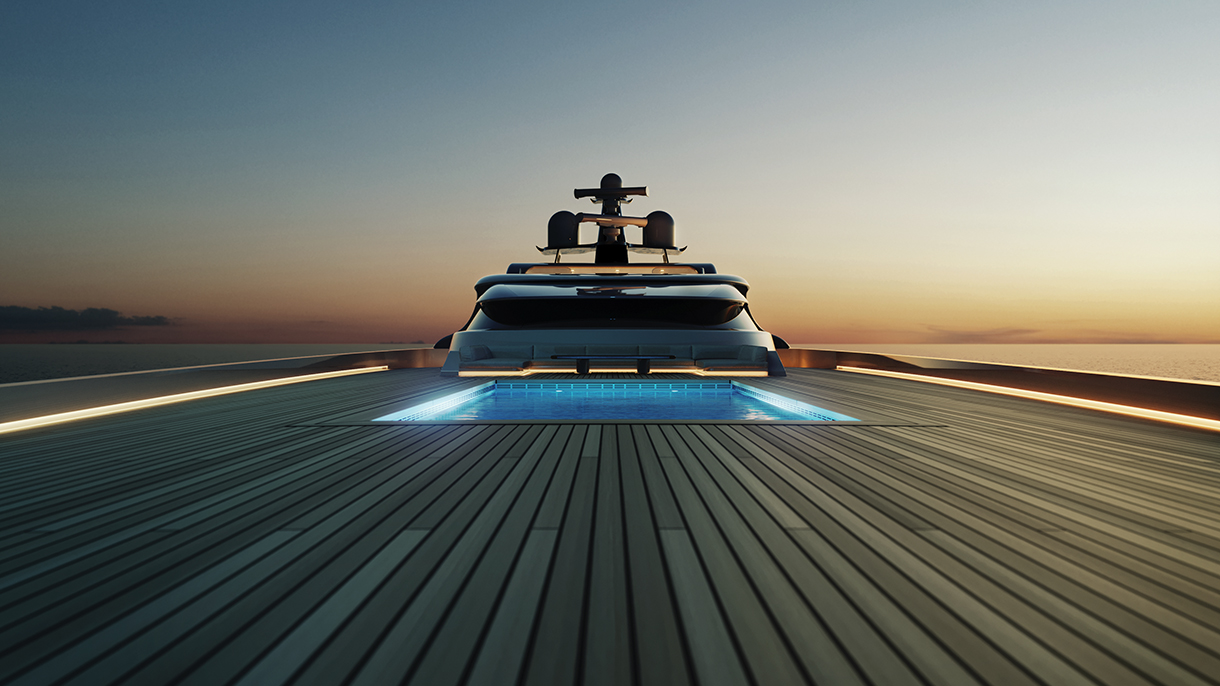
FEADSHIP PROJECT 3073
Dutch shipyard Feadship is no stranger to innovation, having designed and built some of the most cutting-edge yachts on the water. Its 207-foot sport yacht concept, dubbed simply Feadship Project 3073, would be made entirely of aluminum and feature a shallow draught intended for speed. In lieu of traditional propeller motors, large water-jet engines that suck up ocean water and shoot it out the back would generate propulsion and a top speed of 30 knots—a staggering speed for a yacht this size. Feadship indicated that the design could potentially incorporate electric propulsion and still achieve speeds up to 20 knots. For the interior, the shipyard has envisioned multiple innovative onboard features, including an open-concept main saloon that leads up to the bridge-deck wheelhouse via a pair of sweeping staircases, and a large foredeck swimming pool with a glass bottom that would cast shimmering light into the owner’s suite below. feadship.nl
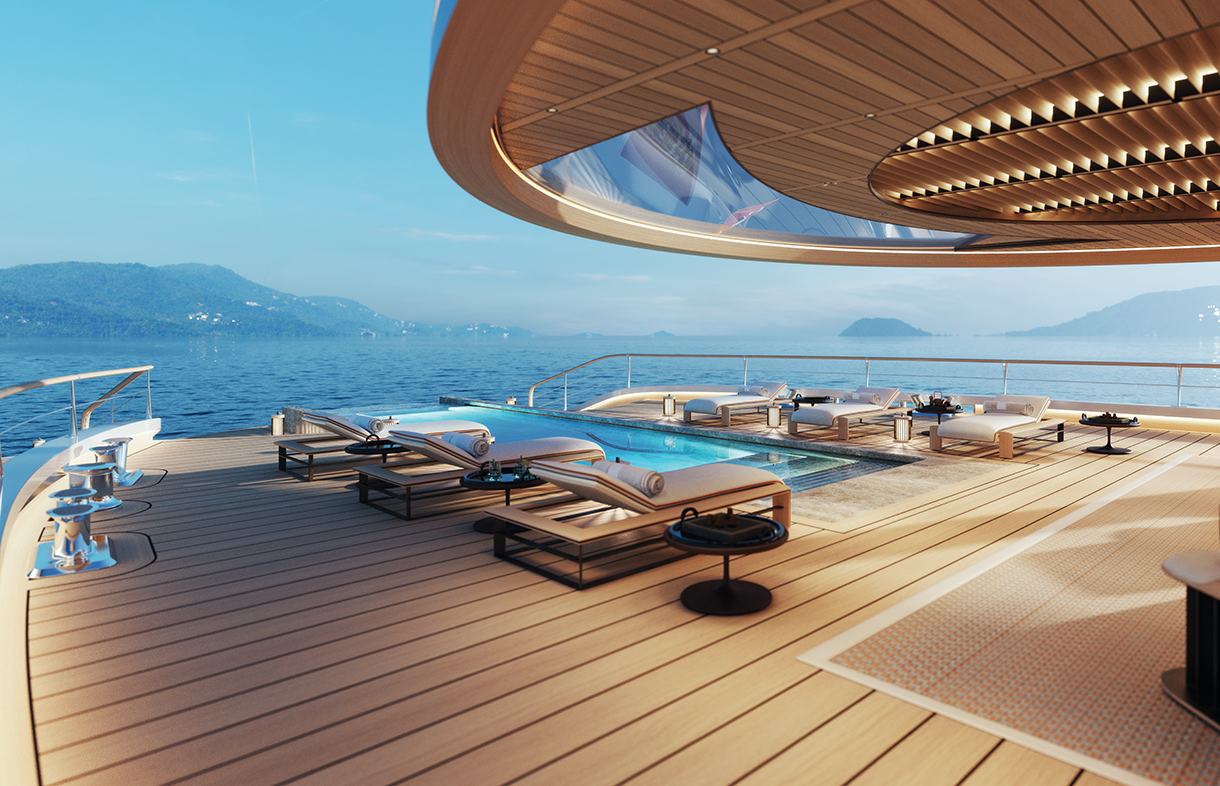
AQUA
Sinot Yacht Architecture & Design provides a clear vision for the future of yachting with its innovative concept yacht Aqua. The centerpiece of this cutting-edge design is a zero-emissions propulsion-and-energy system relying on fuel cells that use a proton-exchange membrane to convert liquid hydrogen into electricity with water as the only byproduct. Another point of innovation is the yacht’s exterior design, which incorporates huge bands of floor-to-ceiling windows into the hull of its main and upper decks. The curvaceous five-deck hull—measuring 357 feet long and inspired by the swell of ocean waves—culminates at the bow of the upper deck, with a glass-walled observatory in the massive owner’s suite. Notable features of the spacious interior (with ceilings as tall as 12 feet) include six staterooms, a large water-level wellness center, a massive swimming pool cascading down the aft deck, and a central circular staircase. The glass-walled display on the lower level houses the two 28-ton hexagonal vacuum tanks that hold the ship’s liquid hydrogen fuel at minus-253 degrees Celsius. sinot.com
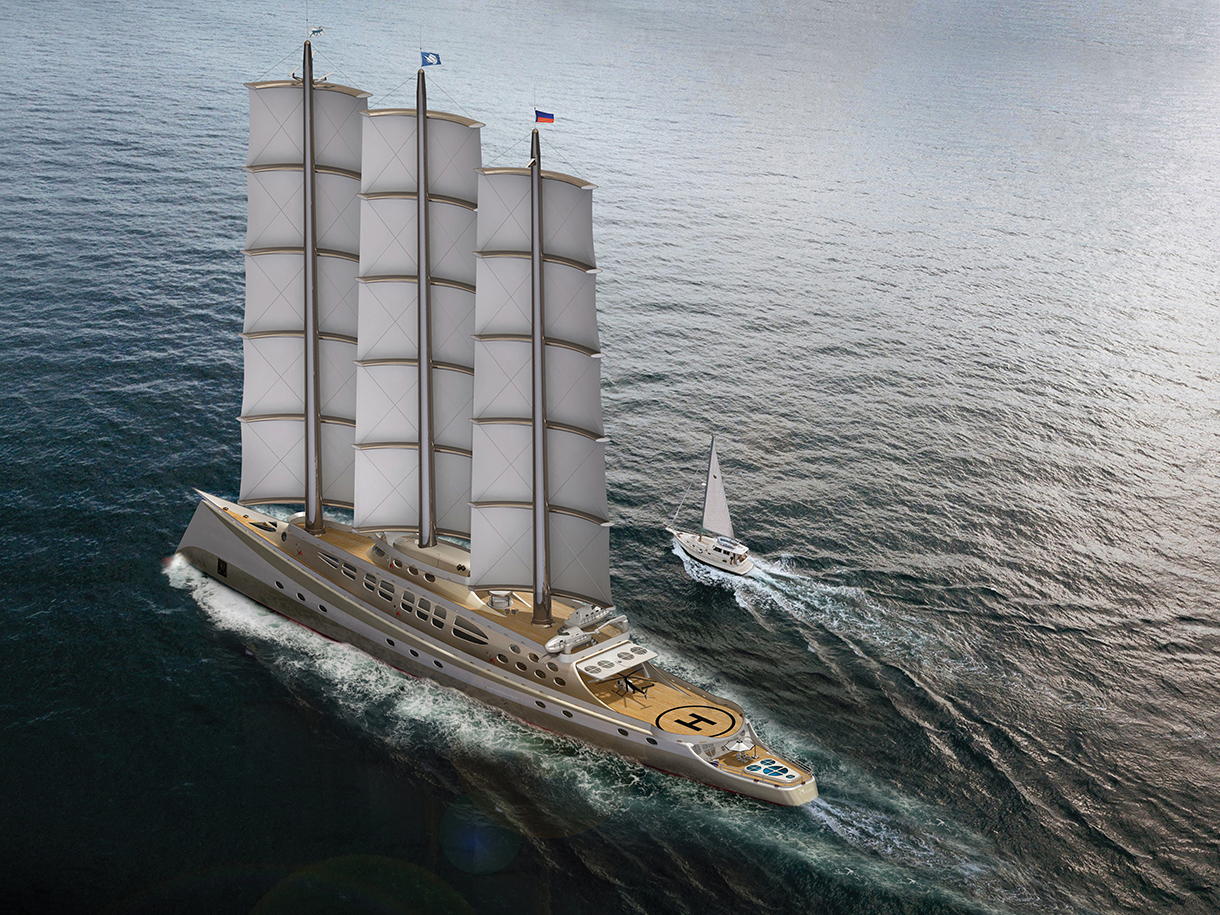
CARIBÙ
From Steve Kozloff, designer of the Goliath Series expedition vessels, Caribù would be a 370-foot globe-trotting sailing yacht chock-full of features intended to help the ship handle long hauls and withstand the planet’s harshest climates. Under diesel-electric power, the yacht could cruise at 15 knots for up to 6,000 nautical miles, a range greatly extended by nearly 33,000 square feet of DynaRig sails across its three masts. The steel, polar-class hull could break through ice and the yacht’s design incorporates de-icing and heating systems throughout. Its onboard pool and spa could be concealed by retractable covers in rough waters. With a large helideck and aircraft hangar, Caribù could sail with three small helicopters, even in harsh conditions, while a pair of heavy-loading cranes would enable the yacht to carry research equipment or offload large tenders. The spacious interior is designed with room for two master suites and staterooms for as many as 14 guests, plus quarters for 20 crew. thegoliathseries.com
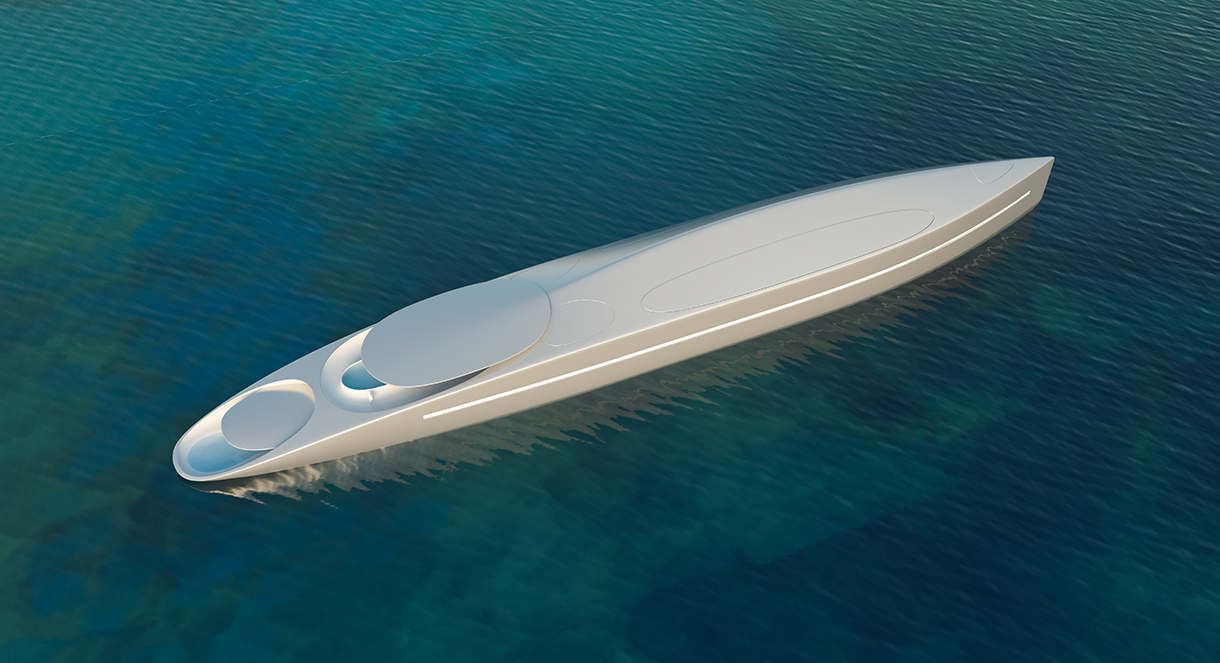
PROJECT L
Thierry Gaugain is a visionary yacht designer, having worked alongside Philippe Starck for some of yachting’s most recognizable designs, including both the motor and sailing yachts named simply A and the late Steve Jobs’ yacht Venus. For his 394-foot concept yacht Project L, Gaugain envisioned multiple groundbreaking elements. The exterior would seamlessly blend one-way glass with the paint of the hull and superstructure, both of which would reflect the surroundings, creating an ever-changing sculpture on the water. The yacht’s onboard spaces would be stretched across one massive open-plan deck, entirely concealed by the opaque exterior, except for two aft portions covered by large oval panels that slide up the superstructure to expose one of two swimming pools (one saltwater and one fresh water) and the expandable water-level swim platform at the stern. The yacht also features a drive-in tender garage and a submarine escape pod that deploys from within the underside of the hull. gaugain.net
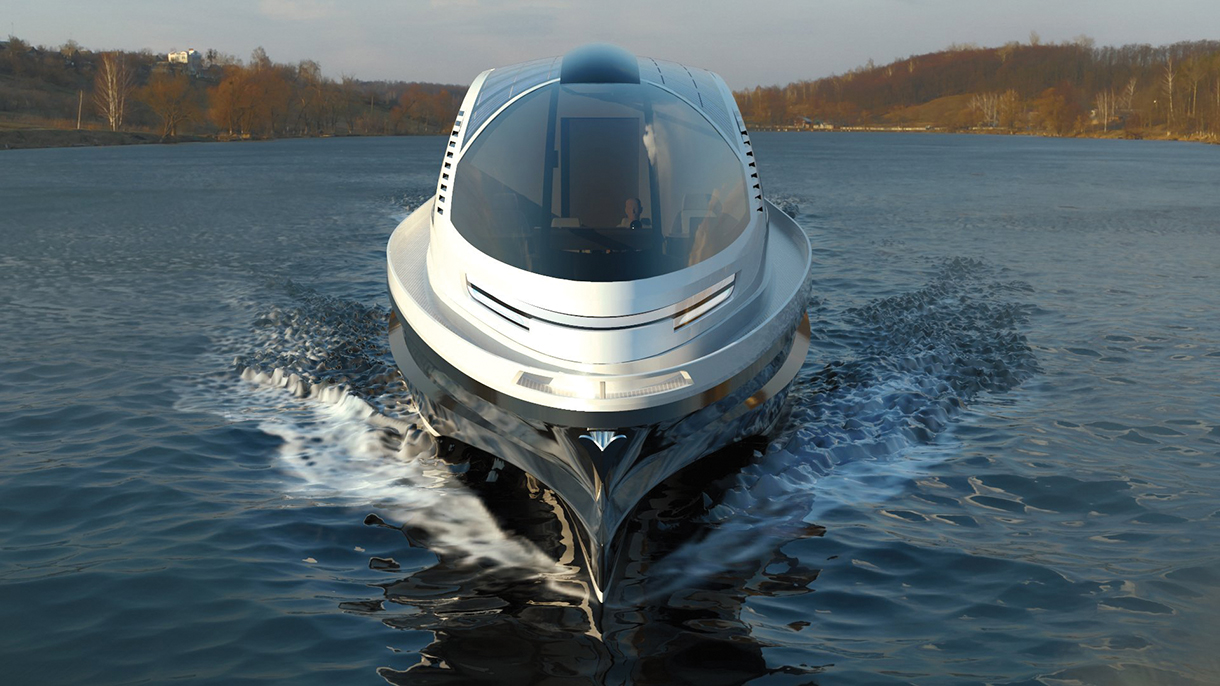
XENOS
Lazzarini Design Studio calls its Xenos concept a “hyperyacht” and says it would push the boundaries of speed for a 130-foot yacht. Available in various power and layout configurations, Xenos could be equipped with as many as four jet drives churning out more than a combined 15,000 bhp, rocketing the yacht to a 90-knot top speed (which is exceedingly fast even for much smaller speed boats). The design also allows for a traditional hull or hydrofoils to further maximize speed and either a hybrid or fully electric propulsion system with an eight-hour capacity. The superstructure—enclosed in photochromatic windows that change transparency based on sunlight intensity and roofed with solar panels for auxiliary power—could be configured with 180-plus seats in a transport-style arrangement or as a private yacht. The private setup includes such features as a dropdown swim platform at the stern and a one-car garage enclosed by a hydraulic door in the aft portion of the superstructure. lazzarinidesign.net

AVANGUARDIA
If it looks like a swan and acts like a swan, it must be a swan—until the head detaches and swims away. As the yacht’s silhouette suggests, Italian designer Pierpaolo Lazzarini of Lazzarini Design Studio drew inspiration from the shape of a swan for his Avanguardia concept. The most distinguishing feature of the 450-foot, curvaceous design is the crane extending back and upward from the bow in a neck-like sweep. Built in two segments and with three hinge points, the neck maintains a level head (aka the control tower) as it nestles against the yacht’s fore superstructure or extends all the way forward to settle on the water. From that point, the eerily avian head can detach as a 52-foot boat. If the yacht’s supervillain owner needs an alternate method of escape, Avanguardia is also equipped with a car garage, two helicopter hangars, and a pair of jet capsules: pod-like boats measuring 26 feet long by 12 feet wide that can dock in the yacht’s wet garage at the stern to provide auxiliary propulsion. lazzarinidesign.net

NEMESIS ONE
At 332 feet long and with a 50-knot top speed, Nemesis One would be the fastest hydrofoil sailing catamaran—if it ever gets built. Its design, which calls for lots of carbon fiber and includes exciting innovations, features an onboard computer system that would eliminate the need for manual rigging by controlling all performance elements, including the hydrofoils and sail. As the yacht reaches high speeds, a system of laser-radar sensors feeds data to the computer to determine the optimum point at which to engage the hydrofoils. When this happens, dual hulls lift out of the water so the boat rides on the hydrofoils, greatly reducing drag and increasing speed. The computer also controls the wingsail to automatically optimize performance. When not under sail, the yacht would be powered by a retractable propulsion system utilizing both hydrogen and solar electricity to generate power. Beyond its performance and technical innovation, Nemesis One would feature comfortable interiors able to be easily adjusted between racing and charter configurations. nemesisyachts.com
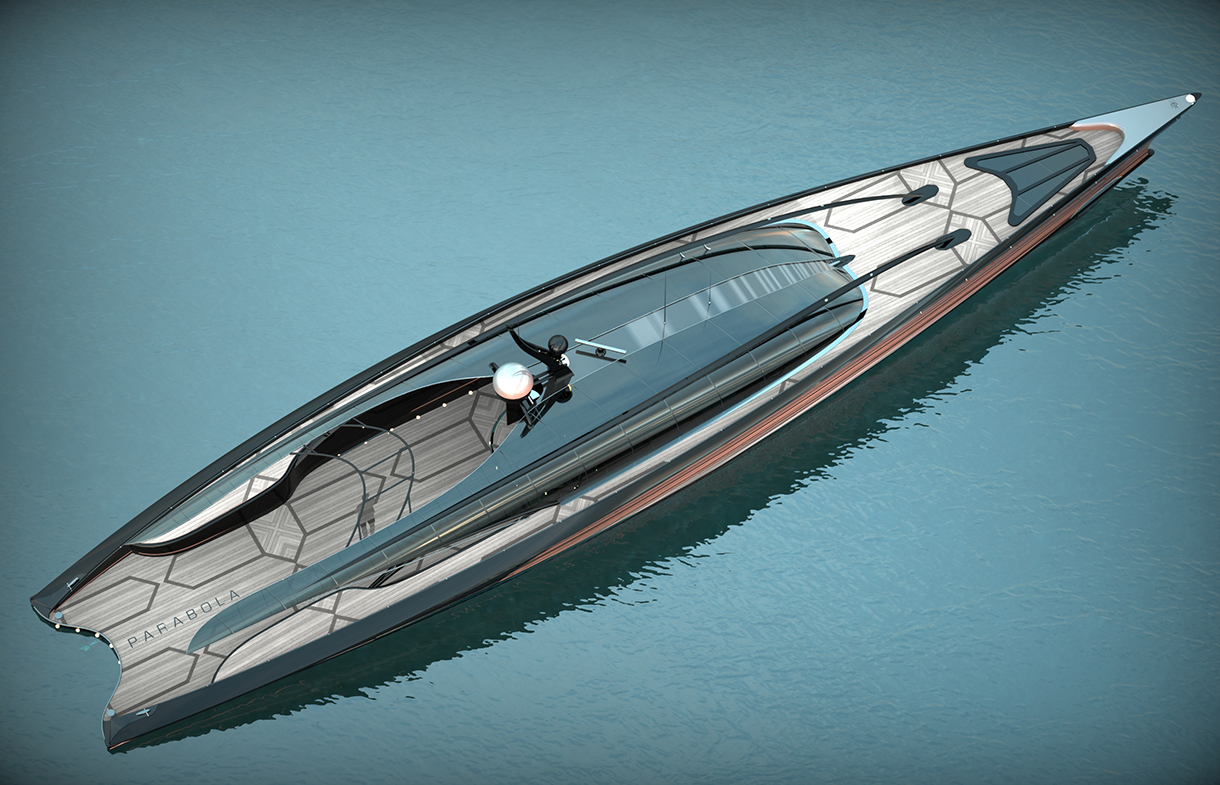
PARABOLA
David Weiss, founder of Designova Creative, conceived of Parabola as a go-anywhere, do-anything support and transport vessel for a larger host ship (specifically for a 270-foot globe-traveling performance sloop). Parabola’s hull shape draws inspiration from performance sailing yachts, with the addition of a wave-piercing gouge-chisel bow to help the yacht achieve a 40-plus-knot top speed. The design allows for day trips to coastal destinations or for inland travel up larger rivers for wildlife expeditions or to explore tropical regions. Parabola employs a non-distorting, 360-degree-by-180-degree curved canopy for observation and protection from the elements. The semi-closed deck space is available with a series of modular arrangements to serve diving expeditions, wildlife observation, open-air educational workshops, or small submersible transport (with a hidden anchoring system embedded in the decking). But at 92 feet, Parabola could also serve as a standalone cruiser with the speed capabilities of a go-fast boat and the elegant design of a cutting-edge yacht.




